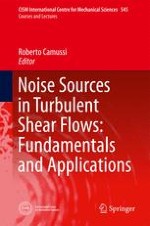2013 | OriginalPaper | Buchkapitel
Boundary Layer Noise – Part 2: Interior Noise Radiation and Control
verfasst von : Paolo Gardonio
Erschienen in: Noise Sources in Turbulent Shear Flows: Fundamentals and Applications
Verlag: Springer Vienna
Aktivieren Sie unsere intelligente Suche, um passende Fachinhalte oder Patente zu finden.
Wählen Sie Textabschnitte aus um mit Künstlicher Intelligenz passenden Patente zu finden. powered by
Markieren Sie Textabschnitte, um KI-gestützt weitere passende Inhalte zu finden. powered by
This chapter is focused on the interior noise caused by a Turbulent Boundary Layer (TBL) relative fluid flow over the flexible thin walls of an enclosure. This is a typical interior noise problem encountered in surface and air passenger transportation vehicles. When such vehicles travel at high speed, the airflow around the skin develops into a TBL. This phenomenon produces large pressure fluctuations that effectively excite the skin panels of the vehicle, which, in turn, radiate noise into the interior.
The formulation for the coupled structural–acoustic response to a TBL pressure field is first introduced for a general model problem given by a cylindrical cavity bounded by a thin flexible wall, which is immerged in a convected fluid that has developed a TBL. Structural vibration and sound radiation effects are expressed in terms of the Power Spectral Densities (PSD) of the wall flexural kinetic energy and cavity acoustic potential energy.
A reduced model problem is then analysed in detail by examining a small section of the enclosure flexible wall and assuming a heavily damped interior. In this case a simplified model is used, which considers a rigidly baffled flat panel with unbounded fluid domains on the two sides. The panel is excited on the exterior side by the pressure field generated by a TBL fluid flow and radiates sound on the interior side. To facilitate the analysis, the PSDs of the panel flexural kinetic energy and interior sound power radiation produced by the TBL pressure field are contrasted with those produced by harmonic acoustic plane waves, by a stochastic acoustic diffuse field and by the so called “rain on the roof” stochastic excitation.
The chapter is then completed with two sections illustrating the principal effects produced by mass, stiffness and damping passive treatments and structural–acoustic active systems on the panel. The first active system consists of an array of decentralised feedback loops with point sensor and actuator transducers while the second active system is composed by a single channel feedback loop with distributed sensor and actuator transducers.
